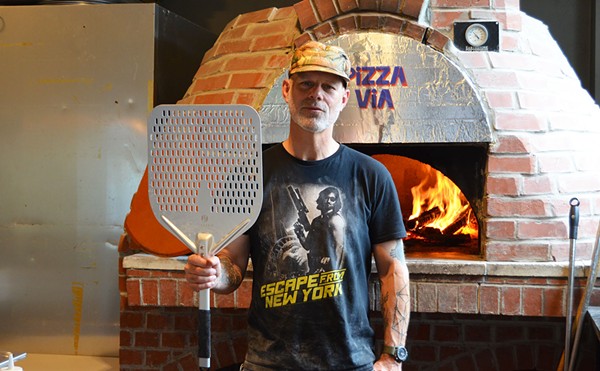On a recent muggy evening, with Chez Leon's air conditioning on the fritz, Bierbaum's florid complexion glowed crimson against his shock of snowy hair. He was dressed incongruously in a plaid shirt, as though William F. Buckley had morphed into Lamar Alexander. Bierbaum opened Chez Leon with restaurateur Eddie Neill in 1999 and has been the sole owner since purchasing his partner's share of the business a few months ago.
The place has a quaint ambience that inevitably inspires local writers to gush that it's "just like a little Paris bistro," or some such blather. With Bosnian waiters, a no-smoking policy and an absence of canines, it's safe to say that Jacques Pepin wouldn't become disoriented if he were to wander in off the street. But Chez Leon has undeniable charm. Its glossy taffy-apple-red façade has more windows than a double-decker bus. Inside, a mural depicting canted rooftops and Gallic flags might have been copied from a Madeline storybook. The ersatz brasserie look is clinched with a few French advertising posters and a narrow line of mirrors stretching behind the banquettes.
This gleaming package is tarnished, however, by neglected chores. The pendulous convex lighting fixtures are huge and handsome, drawing the eye upward. Scores of moths, perhaps obeying their deceased relatives' exhortations to enter into the light, have expired and come to rest in the bellies of these hemispheres. Gazing up at the outlines of the moths' feathery corpses does not make for a romantic tableau. And the two unkempt restrooms, which seem to have been designated unisex only because that's oh-so-European, should be spruced up periodically each evening.
Chez Leon's table service teeters from lax to brisk, a sign that Bierbaum needs to focus on staff training and retention. On our first visit, the waiter was genial but overlooked a number of fundamental tasks, the most important of which was to explain the prix-fixe menu. An $18 main course with two other plates, such as an appetizer and a dessert, costs $28. That's a good value, but about one-third of the entrées require the diner to pay a premium. Tack on an additional $12, for example, if you order rack of lamb or sole meunière. And most diners will have to factor in the price of wine as well. The all-French list includes nearly 75 bottles, about 15 of which go for $30 or less.
On our next visit, we were assigned a crack waiter who remembered to pitch the house pâté, notify us that dessert soufflés must be ordered 20 minutes ahead of time and describe the banquet-style side dishes paired with the entrées. We'd been dismayed to discover during our previous visit that the kitchen takes an assembly-line approach to garniture, fitting out every entrée with almost identical sides. Fish plates, for instance, were accompanied by ratatouille, a carrot-turnip medley, basmati rice and a green minimuffin variously described by the waiters as a spinach timbale, spinach flan and spinach custard. For meat dishes, the rice was swapped with gratin dauphinois, or scalloped potatoes. Repurposing the same tedious sides for almost every main course is cost-efficient for the restaurant but stupefying for the diner, like sitting through back-to-back episodes of A Wedding Story.
Chez Leon's new executive chef is Eric Brenner, who has previously manned the stove at Truffles, Z and the Bistro at Grand Center. His cooking is what the French would call "correct," but the menu is not particularly stirring. The only entrée that breaks out of the side-dish doldrums is choucroute garnie, sauerkraut teamed with a pork chop and sausages. Brenner's sauerkraut has an assertive tang but is not as astringent as some versions. Mustard to dab on the meat was served in a porcelain jar with an unappetizing crust around its lip. Condiments may be palmed off from table to table at Outback, but we expect better at a place like this.
Choucroute garnie, despite its German-sounding name, is a French dish that originated in Alsace, a province bordering the Rhine. But does Chez Leon's menu represent France's diverse regional cuisine, or does the restaurant simply cater to parochial perceptions of what French food is? The selection of soups is characteristic of Chez Leon's myopic fare. When we visited, the kitchen was offering French onion and potato-leek, two overexposed soups whose unfathomable popular appeal is rivaled only by that of Celine Dion and the kid in the Dell commercials.
Brenner's seafood dishes are limited to finfish, scallops and shrimp. We'd like to see the lineup broadened to include more eccentric choices, such as skate, sea urchin and ceviche. During our visits, shellfish was served only as a first course. Coquilles St. Jacques, as it is traditionally prepared in Normandy, comprises scallops elegantly arranged in a scallop shell (coquille means "shell"), sprinkled with breadcrumbs or Gruyère cheese and broiled to form a crisp, nicely browned mantle. The only resemblance Brenner's dish bears to the original is that it includes scallops. They reclined nakedly on a white plate, clothed only in a beurre blanc that had broken, the butter having separated from the other constituents of the sauce. A first course of shrimp with lemon vinaigrette was no improvement. The prep cook had apparently forgotten to salt the water before boiling the shrimp, leaving them with virtually no flavor. Touted as "chilled" shrimp, the four small shellfish sweated it out on plates still warm from the dishwasher. The same problems cropped up in a salad: The heated plates wilted the field greens, and the diced beets lacked seasoning. Tart crumbles of Roquefort cheese contributed the only salt in the salad.
Brenner's entrée selections are likewise conservative. The seafood roster includes three types of finfish -- halibut, salmon and sole. The fish is filleted and prepared with parsley and lemon in the modest meunière ("miller's wife") style. Our scant portion of sole did not have an especially fine texture or exceptional flavor, and we wonder whether the $12 surcharge added to the prix-fixe dinner (or $30 for the sole entrée by itself) is too steep. Halibut, as chic as it is now, hasn't always been in vogue. In the nineteenth century, it was difficult for fishmongers to unload their halibut until the rest of the day's catch had been sold. The fish's opaque flesh is milky white but tends to be dry. Brenner grills the halibut and steeps it in a pool of basil vinaigrette whose flavor is milder and less oily than that of an Italian basil pesto.
Beyond the slate of seafood, the choices are about as dynamic as Queen Elizabeth's headgear, and they don't seem uniquely French. Where are the veal kidneys, the hares, the poussins, partridges and pheasants? The menu includes one lamb dish, unaccountably trumpeted as rack of Colorado lamb. The meat was not presented as a rack but instead was jointed into two cutlets, individual eyes of lamb with the long white rib bones dramatically exposed. It was a well-executed dish, the meat grilled spot-on medium rare and enrobed in a port reduction scented with rosemary.
Chez Leon's dessert list is composed of timid classics. Profiteroles (miniature cream puffs) are filled with lovely house-made vanilla, chocolate and raspberry ice creams. The choux pastry, however, tasted as though it had been frozen and then crisped in the oven. A crumbly pastry case filled with a puckery custard toted up to a fetching lemon tart. I had planned to take issue with the warm chocolate cake, sometimes referred to as "soufflé cake" or "molten chocolate cake." This confection is a purely American trend that grew wearisome faster than you can say "connect the dots." But before I began my harangue, I noticed that "hot chocolate upside-down soufflé with pistachio ice cream" had turned up on this week's menu at Daniel, New York City's top French restaurant. I'm afraid this dessert will have to join the ranks of tiramisu, crème brûlée and nondairy whipped topping in the "losing battle" column.
Eric Brenner is clearly an accomplished chef, and we hope that Bierbaum gives him free rein to experiment in the kitchen. Too many restaurateurs are unwilling to stray from the formula to which they attribute their early success. But restaurants are like lovers: They have to try harder as middle age sets in. It's time for Chez Leon to woo us with some new moves.





